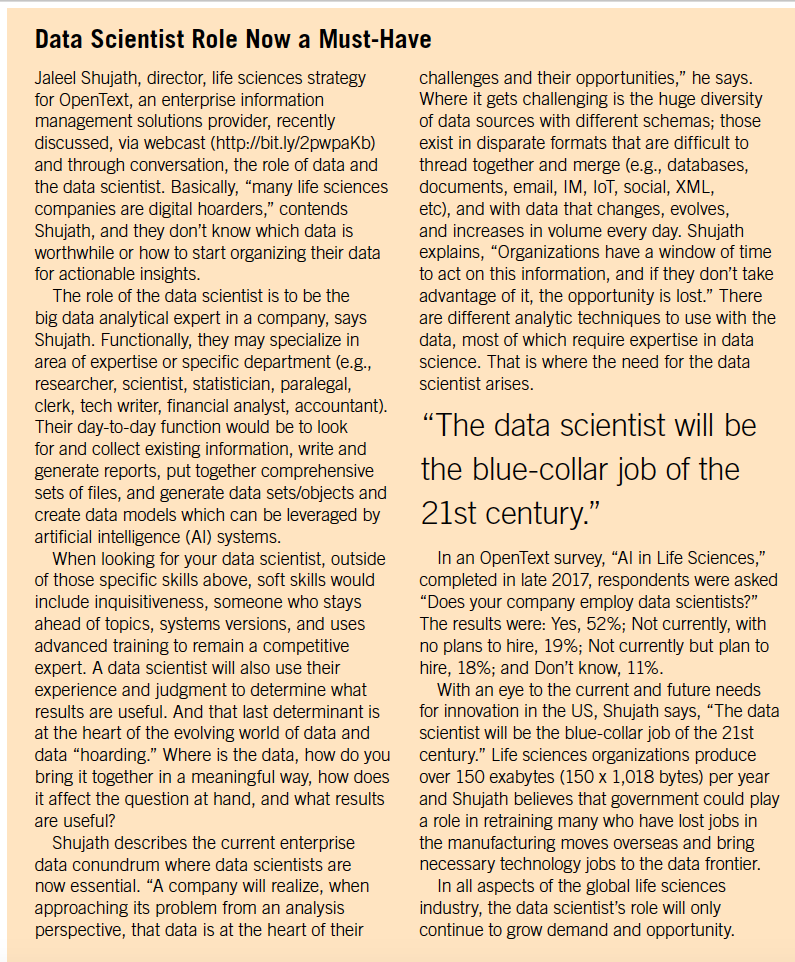Rewriting Pharma’s Talent Blueprint
Pharmaceutical Executive
Amid rapid shifts in technology and consumer engagement, Pharm Exec explores how new models in hiring and recruitment-along with the evolution of the C-suite-are reshaping biopharma’s talent path of the future.
How new models in hiring and recruitment-coupled with the evolution and addition of C-suite functions to keep pace with technology and consumer shifts-are reshaping biopharma’s talent path of the future
If you are searching for the best current example of the future career path of pharmaceutical executives, look no further than the April 2017 appointment of GlaxoSmithKline’s CEO Emma Walmsley. While she has been with GSK since 2010, Walmsley joined the pharma giant after 17 years with L’Oreal, where she held a variety of marketing and general management roles, wrapping up as general manager, consumer products for L’Oreal China. Walmsley entered GSK through that consumer door, and is now the first female CEO of a large pharma company.
It may be that consumer door, along with a few additional windows, that will bring the fresh breeze of insights into the traditionally closed-off pharma industry. “Pharma has been very incestuous,” says Srini Shankar, vice president, life sciences, with Cognizant, an information technology and services company. “It’s only as recent as five or six years ago that they only hired from within the industry. If you didn’t have pharmaceutical experience, they wouldn’t look at you.”
But with the rapid change of digital technology and consumer shifts within the larger healthcare industry, the need to leverage experience from other industries, coupled with new ideas and ability to create synergies, means a new breed of talent is needed.
Srini Shankar

To that end, many pharma companies are looking for digital or marketing experience from other sectors, be it consumer goods, retailers, or the adjacent healthcare industry-places where the customer experience is central. Srini says professionals from these other industries can translate that consumer knowledge and apply it to the patient journey, for example, or create a more efficient supply chain.
“I don’t want to be ‘Amazon’d,’ the pharma company might say,” explains Srini, “but how do you efficiently build a supply chain, from sourcing to delivery to the pharmacy? The conversation has moved away from, ‘oh, you don’t have pharma experience’ to ‘we need that.’”
Clearly, understanding the future of pharma means using technology to parse through massive quantities of data for a variety of decisions. Data for understanding patient adherence, informing new drug candidates (or new uses for old ones), targeting physicians, evaluating outcomes and real-world evidence, lean manufacturing…the list is endless. Examples abound in Walmsley’s reign. She created the position of chief digital officer, hiring Karenann Terrell, the former chief information officer at Walmart, who will use new technology in data analytics and cloud computing applied to drug development. GSK also added Marc Speichert, formerly of Google, as its chief digital officer for the consumer unit.
Sidebar: Data Scientist On Rise

Srini notes that half of Cognizant’s clients now have a chief data officer. “The CDO has an understanding of data and where that data exists within the context of the industry,” he says.
They are then supported by another growing position, data scientists. While biostatisticians are a specialized and familiar role in life sciences, the role of the data scientists that report into the CDO is to find the insights within the data. Specifically, to integrate, mine, and track data patterns using technology (see sidebar at left; click to enlarge).
R&D to R&C
If research and development were considered the core competency of traditional pharma, experts at Russell Reynolds Associates, the executive search and talent advisory firm, point to pharma’s core now being research and commercial (R&C, if you will). “Big pharma is moving out of development and keeping research and the commercial end,” says Waseem Noor, a consultant with Russell Reynolds. He adds, “If you look ahead, there is more in-licensing of compounds or technology, and a steady outsourcing trend for development to the CROs (contract research organizations).”
Two growing areas that sit closely together in the new model are medical affairs and market access. The market access function has come into its own over the past five years. Navigating physician access, patient access, country access, and communicating value to payers, providers, and governments for pricing,
Waseem Noor

reimbursement, and marketing purposes is complex-and increasingly more specialized. “We see more and more strategic value for the market access role,” says Noor.
The medical affairs function has been around for a long time, but is now getting a makeover, which some call Medical Affairs 2.0. Noor explains that this new role is much more involved in speaking to physicians and physician key opinion leaders (KOLs) to communicate the value of a product, in their language. In place of the sales rep that visits with samples and lunch, medical affairs is now a more focused partner that can help physicians with educational materials, as well as scientific evidence.
“Scientific analysis along with medical affairs provide a lot of market-based input for companies,” says Noor. “Medical affairs understands regulatory review and can help transform business models and commercial strategy.” (For more about the evolving medical affairs role, see this article).
Executive options
The older model for large, traditional pharma was a system that created a planned succession of leadership. This model, explains Noor, was not just in pharma but a model of the Fortune 500. However, specific to the drug industry, is the last decade of venture capital (VC) making smaller biotechs more attractive to individuals in the C-suite or at the C-minus two level. Add to that mix the large number of M&As in the industry, and two major implications result. “Mergers mean fewer and fewer positions for pharma for the top level, combined with other biotech and small pharma alternatives for people to go into,” says Noor. “Both of these forces have led to the upending of the CEO succession planning.”
While pharma can take new talent from the consumer worlds, those already entrenched in pharma can find new life in biotech. As Noor notes, VC’s impact has been felt in the biotech hubs. Additionally, familiarity with business development and purchasing or in-licensing biotech compounds leads to the further attractiveness of the research end of the business.
John Rynak, a senior HR and staffing consultant located in Cambridge, Mass., noted that many senior executives from traditional pharma have headed into biotech in the last several years. “They are stifled by bureaucracy and the lack of creativity in the large companies,” says Rynak. Another difference with the large pharma vs. VC-controlled biotech is the speed with which programs are ended. “In large pharma, you have people who hold onto programs that should have been killed five years ago. They are spending a lot of money chasing a bad idea,” explains Rynak. “VC is more willing to pull the plug and sell the technology…pull it quickly if the science wasn’t there.”
Matt Vossler is a partner with recruitment firm RSA, which handles executive placement for mid-size, specialty, and early stage pharma companies. From his standpoint, there is a balance and a definite window of opportunity for fleeing pharma in search of a promising biotech. “A biotech may say we don’t want big pharma [candidates], if they have just come from a longer period, say 15 years,” says Vossler. “They want
Matt Vossler

someone with that large pharma experience, but maybe a bit removed from that. Say a mid-size pharma or CRO or an institution.”
Vossler explains that the smaller companies tend to need individuals to hit the ground running and who wear lots of hats. And maybe someone not used to accessing large budgets. “Sometimes people come in and have no budget for things they used to, and they have to work with that,” says Vossler.
In general, so far this year, Vossler has noted a very robust hiring season. “We are seeing demand for combination or hybrid skill sets; for example, a medical leader possessing both an early clinical development and medical affairs background,” he says. “And an executive with strong commercial experience, with a PhD-level scientific background, will most likely be using all of their skills daily in these smaller companies."
Vossler says the landscape in pharma today is highly competitive, and one where companies may be looking for a very specific type of executive from a therapeutic standpoint. That can be critical when it comes to interactions with regulatory authorities, or managing a KOL network, for instance, he notes.
On the other hand, it may be that some companies don’t know exactly what they are looking for at the outset of a search, but may change or tighten a profile specification after they see a few candidates. For example, Vossler noted a recent West Coast-based chief medical officer (CMO) search that seemed a perfect match for someone with a blend of industry and hospital/academic-based clinical research. Within a few weeks, the company changed its mind, opting for someone possessing a pure academic-based KOL background. On the highly qualified candidate side, Vossler says a recent available position for quality reported into the general counsel, which was not the relationship some of the candidates desired.
Sidebar: Diversifying the C-suite; click to enlarge

“In smaller companies, reporting structures with individuals and teams can be unique based on the skills and experiences of leadership, and things can change quickly, too, depending on timing, as well as who comes in and how they want to structure things,” says Vossler.
Rynak agrees that the more senior the executive, the more change that can happen in reporting and organizational structures. “We find that when launching a biotech, it is easier to start with the top-down approach, rather than staffing bottom-up,” he says.
Outside of the core CEO, financial, etc., experience, the other major contributors in biotech are the scientists, which is why the biotech hubs have been bubbling along in areas rich with technical and scientific graduates.
The traditional roles
Not to say that pharma has no need for the tried-and-true functions, where a professional pedigree is not only required, but in high demand. Roles such as biostatisticians, or those in the clinical and scientific fields, which can be contracted to offer companies project flexibility and expertise. Thirteen years ago, Jack Schink, former director of procurement within Novartis’ business services organization, transitioned from a staffing-aligned managed service provider (MSP) to a vendor-neutral contingent workforce management program not aligned with a staffing agency-with the objective of sourcing, tracking, and managing the company’s non-employees (e.g., contractors, temps, freelancers).
In this case, Novartis selected PRO Unlimited as its vendor-neutral MSP, which continues to handle supplier management, on-and off-boarding, market rate guidance, and compliance-all of the areas that Schink says were not part of Novartis’ core competency.
“In the pharmaceutical industry, there is so much competition among companies for specific roles that not all large staffing suppliers have access to these specialized workers,” he says. “PRO’s model leveled the supplier playing field. It allowed for smaller, more niche staffing firms to compete with the larger firms for requisitions. Essentially, PRO’s vendor-neutral approach ensured that we identified the right talent at the right time at the best market rate-something that we could not accomplish with our prior staffing-aligned MSP.”
Schink adds, “Beyond supplier management, we realized significant cost-savings from outsourcing the program. We managed to bring spend under control fairly quickly and increase program adoption, which helped to consistently deliver around 5%-8% year-over-year savings.”
Lisa Henderson is Editor-in-Chief of Pharm Exec. She can be reached at lisa.henderson@ubm.com. Follow Lisa on Twitter: @trialsonline
